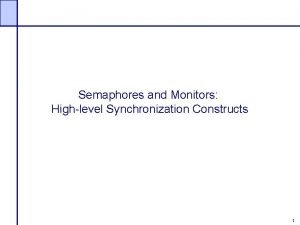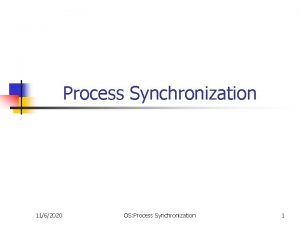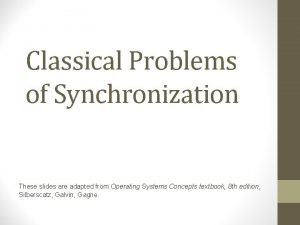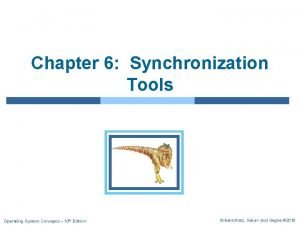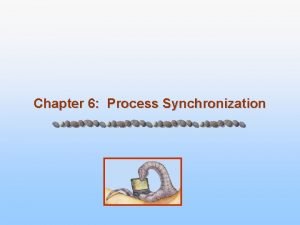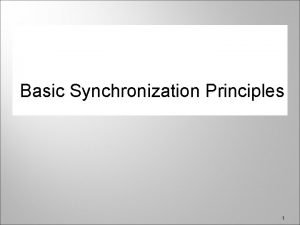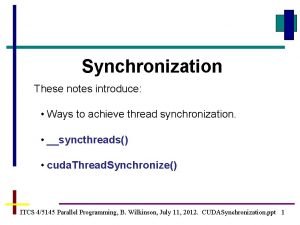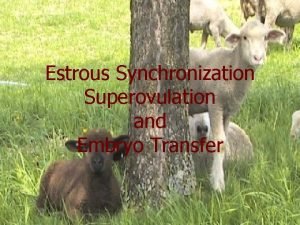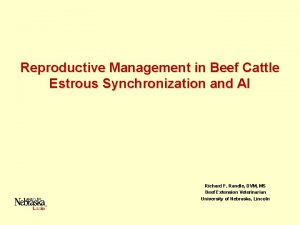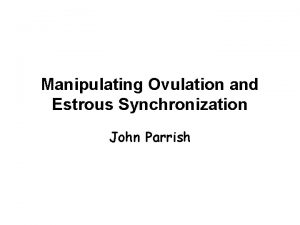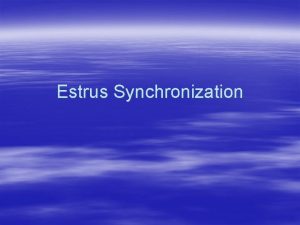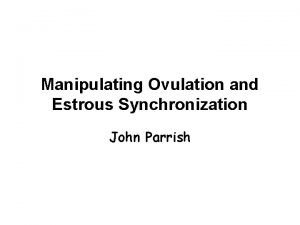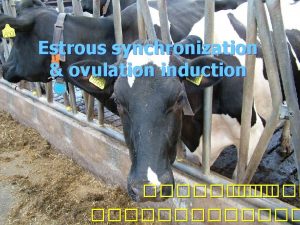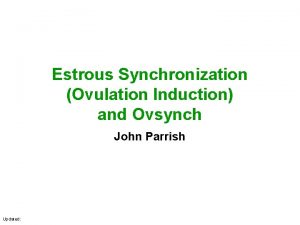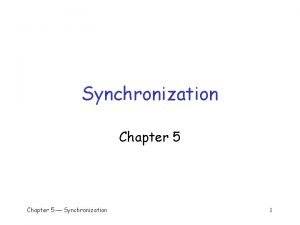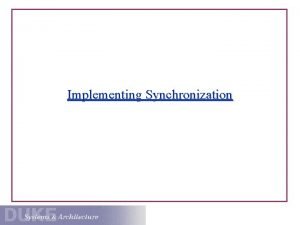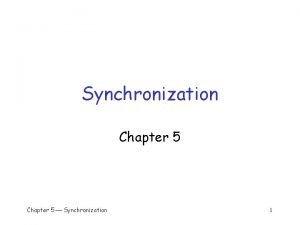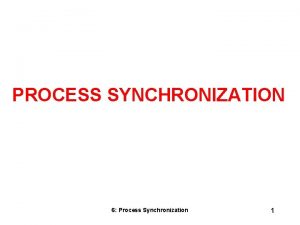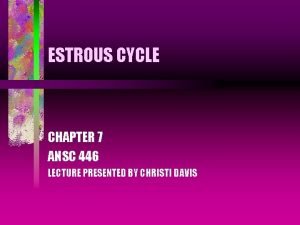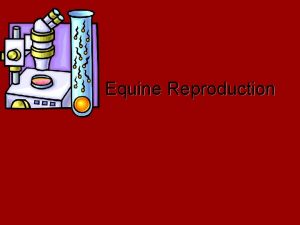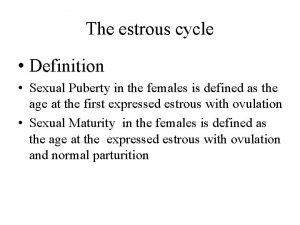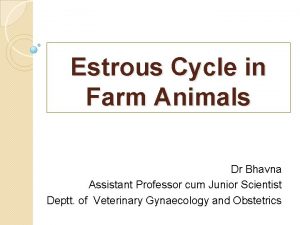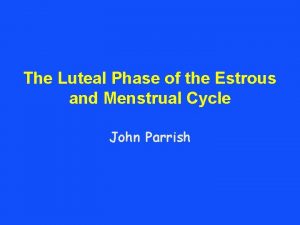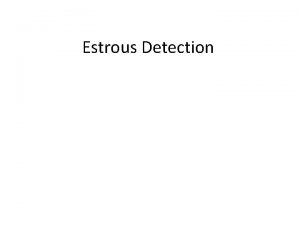Estrous Synchronization Estrous Synchronization A management technique that
























- Slides: 24

Estrous Synchronization

Estrous Synchronization A management technique that makes use of hormones to control or reschedule the estrous cycle Hormones associated with reproduction LH & FSH Progesterone Estrogen Prostaglandin

Why synchronize? n Group females for parturition (calving interval) n Shorten breeding season n Reduce estrus detection

Advantages of implementing a synchronization program n Calves produced early in season will wean heavier because they are older n Cows require 40 -60 days to recover from calving before next breeding – Cows that bred earlier have better chance of maintaining 365 d calving interval the next year

Basis for Synchronization of Estrus n Manipulate life span of CL n Manipulate growth of follicles and timing of ovulation

Synchronization Methods Method Tradename Utilization Gonadotropins Cystorelin Fertagyl Mature females Prostaglandins Estrumate Lutalyse Prostamate Cycling females Progestins MGA CIDR Pre-pubertal heifers Post-partum or Anestrous females

Synchronization Methods Gonadotropins(Gn. RH protocols) n Naturally occurring hormone that stimulates the release of LH and FSH that stimulates follicular development n Protocols include Ovsynch and Cosynch

Synchronization methods Prostaglandins – Naturally occurring hormone that causes regression of the CL (luteolysis) and decreases progesterone secretion which results in a return to estrus – Can expect estrus within two days following injection – Protocols include PGF one-shot method and PGF two-shot method

Synchronization methods Progestins n Form of progesterone that extends the period of time progesterone is present and prevents animal from coming into heat n Protocols CIDR include MGA+prostaglandin and

Synchronization methods: drug trade names and effectiveness Method Prostaglandins Progestins Trade name Lutalyse* Estrumate* Prostamate* Equimate∞ MGA* CIDR* Regumate∞ Female “type” for drug effectiveness *Cycling cows or heifers ∞Cycling mares *Cycling cows or heifers *Anestrous cows or heifers ∞Mares * Cattle∞Equine^Swine

Synchronization methods: drug trade names and effectiveness Method Trade name Female “Type” for drug effectiveness Gonadotropin Releasing Hormones Cystorelin* Fertagyl* Ovuplant∞ *Postpartum cows *Anestrous cows ∞Cycling mares Placental Gonadotropins PG 600^ ^Peri-pubertal gilts * Cattle∞Equine^Swine


One Injection of PGF n Advantages – Useful for detection of estrus in heifers and cows – Decreased drug cost – Limited animal handling n Limitations – 10 -25% of females may not be detected in estrus during days 0 to 10 – Poor degree of synchrony on females that return to estrus – Must have CL – Length of estrus detection – Abortion


Two Injections of PGF n Advantages – Useful for detection of estrus in heifers and cows – Tighter synchrony than one injection method – Can use fixed insemination time after 2 nd injection n Limitations – Females must have functional CL – Length of estrus detection – Administration of PGF will cause abortion in pregnant animals


MGA and Prostaglandin n Advantages – Proven system for heifers – Inexpensive method – Can hasten cyclicity in anestrous females n Limitations – Length of program – Must have appropriate feeding space to allow efficient consumption – Estrus synchronization may be variable – Must ensure uniform daily consumption of feed supplement prior to and during oral administration of MGA


CIDR n Advantages – Useful for detection of estrus in heifers and cows – Induces cyclicity in a percentage of anestrous cattle – High pregnancy rates n Limitations – Possible retention failure of CIDR – Cost per treatment may be higher than other methods – An additional day of processing for hormone treatment would be required to facilitate fixed time AI


Gn. RH n Advantages – Higher and tighter rate of estrus synchrony compared to PGF protocols – Allows for estrus detection or timed AI n Limitations – Higher cost due to hormone injections – Increase of time and labor – Not recommended for use in heifers

Synchronization in the Mare Products used: Equimate, Estrumate, Lutalyse n n n When administered in diestrus, expect ovulation in 7 -12 days If 30 -35 mm follicle is present, expect ovulation in 2 -4 days Will only work when fully functional CL is present “short cycling” refers to restarting the estrous cycle early Prostaglandin should be given after day 6 h. CG can be given to mares resulting in immediate ovulation

Synchronization in the Sow Prostaglandin will not cause CL regression until day 12 of cycle because LH binds to luteal cell receptor with strong affinity following ovulation and is not released until day 12. Repeated injections over two to three days will regress CL sooner, but is not practical. n Common progestins will synchronize estrus but cause ovarian cysts n Regumate has been found to be effective n Noncycling gilts can be synchronized with P. G. 600 (400 IU e. CG and 200 IU h. CG)

Synchronization in the Ewe Most common protocols use either use prostaglandins or CIDR
 Canine estrous cycle
Canine estrous cycle Phân độ lown
Phân độ lown Block xoang nhĩ ecg
Block xoang nhĩ ecg Thơ thất ngôn tứ tuyệt đường luật
Thơ thất ngôn tứ tuyệt đường luật Thơ thất ngôn tứ tuyệt đường luật
Thơ thất ngôn tứ tuyệt đường luật Chiến lược kinh doanh quốc tế của walmart
Chiến lược kinh doanh quốc tế của walmart Tìm vết của mặt phẳng
Tìm vết của mặt phẳng Hãy nói thật ít để làm được nhiều
Hãy nói thật ít để làm được nhiều Tôn thất thuyết là ai
Tôn thất thuyết là ai Gây tê cơ vuông thắt lưng
Gây tê cơ vuông thắt lưng Sau thất bại ở hồ điển triệt
Sau thất bại ở hồ điển triệt Fast clock to slow clock synchronization
Fast clock to slow clock synchronization Types of semaphore in os
Types of semaphore in os Process synchronization in os
Process synchronization in os Tally synchronization
Tally synchronization Multiprocessor synchronization
Multiprocessor synchronization What is lean synchronization
What is lean synchronization Basic bgp configuration
Basic bgp configuration Lock free synchronization
Lock free synchronization Classic problems of synchronization
Classic problems of synchronization Synchronization tools in operating system
Synchronization tools in operating system Process synchronization in os
Process synchronization in os Basic synchronization principles
Basic synchronization principles Windchill commonspace
Windchill commonspace Cuda critical section
Cuda critical section












